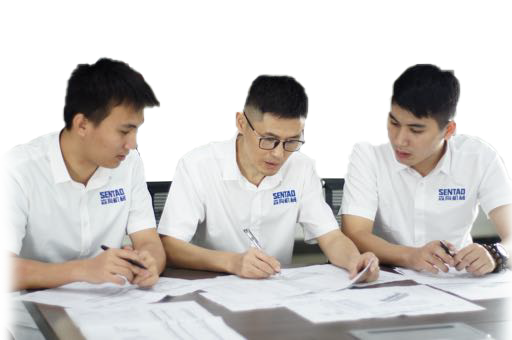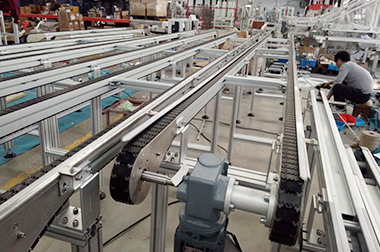Need Help?
We are here to help.
Our sales professionals can assist you in determining the type of components and solutions needed for your custom application.



Logistics conveyor line manufacturers give you a brief introduction to conveyor belt equipment products and their development.
1、Introduction of conveyor belt products
Conveyor belt is generally composed of three parts: skeleton material, cover layer and laminated layer material (the following cover layer and laminated layer are collectively called “cover layer”) and bottoming material, of which: skeleton material is the key of conveyor belt bearing, and is the decisive factor of conveyor belt guiding, loading capacity and extensibility; cover layer material is the normal work of conveyor belt. The characteristics of conveyor belt, such as high temperature resistance, abrasion resistance, anti-static, etc., all depend on the characteristics of the cover layer material; the role of the backing material is to make the bonding strength between the cover layer and the skeleton material good.
According to the different materials of cover layer, conveyor belt can be divided into rubber conveyor belt and light conveyor belt, the former cover layer mainly adopts various modified natural or synthetic rubber, while the latter adopts various polymer modified materials, mainly including modified PVC, PE, TPU, TPEE materials, etc.
Rubber conveyor belts are mainly used for conveying heavy materials in heavy industries, and their main application areas include the traditional five major industries such as steel, coal, cement, port and electric power, accounting for more than 90% of the downstream market of conveyor belts. In some industries such as food processing, textile printing and dyeing, conveyor belts are also involved in the processing process and are key components for the normal operation of automated production and conveying equipment. At present, the application of conveyor belt has penetrated into various industries of national economy and is inseparable from the daily operation of national economy.
In general, the downstream applications of rubber conveyor belts have not changed much in the past decades, still mainly in traditional heavy industry and mining industry, and are developing in the direction of high temperature resistance, flame retardant and high strength according to the special requirements of these industries; while the downstream applications of light conveyor belts are increasing, from light industry and electronic production lines at the beginning of Z to textile printing and dyeing, stone and wood processing, food processing, etc., in addition to the traditional steel In addition to the traditional five major industries such as steel, coal, electric power, cement, port, etc., almost all other fields can be used at present, and its performance and application fields are developing with the development of polymer material modification technology. In the conveyor belt industry, light weight conveyor belt represents the development direction of light weight, safety, environmental protection and energy saving of conveyor belt.
New energy lithium battery assembly line production line

2、Market overview of conveyor belt industry
Globally, the conveyor belt industry has maintained a steady growth in its overall market size with the development of the economy. Currently, the global conveyor belt market size is about 600-700 million square meters per year, and is dominated by rubber conveyor belts, which account for 85%-90% of the conveyor belt market usage, and the proportion of light conveyor belts is only 10%-15%. At home, China’s industrialization is still emerging, and the rapid development of heavy industry provides a high-speed expansion market for the conveyor belt industry, and there is still a need to carry out a large number of energy, transportation and other infrastructure construction in the central and western regions, so as the total economic volume of domestic heavy industry and infrastructure services such as iron and steel, coal, cement, ports, electricity and other industries continues to grow, the domestic conveyor belt market is currently dominated by rubber conveyor belts. In 2008, China’s domestic conveyor belt production was about 250 million square meters, of which rubber conveyor belts accounted for about 95% of the conveyor belt usage. (Source: Double Arrow prospectus, China Rubber Industry Association, “China New Material Light Conveyor Belt Industry Market Research Report” and the issuer’s calculations based on the above information)
3、The global trend of energy saving and environmental protection will increase the proportion of light conveyor belt in conveyor belt
Compared with traditional rubber conveyor belts, new material light conveyor belts have many advantages: First, they are safer and more hygienic. Compared with traditional conveyor belts, TPU products and food-grade PVC conveyor belts are widely used in food processing, agricultural production and other industries because they meet the strict standards of EU and FDA, while TPEE and PE conveyor belts are used as the main belts in tobacco industry because their surface materials meet the requirements of non-toxic burning. In addition to the good characteristics of the cover layer material itself, the physical and chemical modification can make the new material light conveyor belt products have the characteristics of acid and alkali resistance, oil resistance and organic solvent resistance to meet the diversified needs of the downstream industry; again, in the case of similar performance, the weight and thickness of the new material light conveyor belt are much smaller than that of rubber conveyor belt, and the flexibility is much better. It is also more energy-saving.
Therefore, globally, with the application of new green materials and the increasing awareness of environmental protection and energy saving, the conveyor belt industry will develop in the direction of thinness, energy saving, safety and environmental protection in the future, and the proportion of light conveyor belt in the conveyor belt industry is gradually increasing.
Our sales professionals can assist you in determining the type of components and solutions needed for your custom application.

Workshop 1,No.6,Liwei Industrial Zone, Shangbai Avenue,Luocun,Shishan Town,Nanhai,Foshan City,Guangdong,China
Mon — Sat: 8AM — 6PM